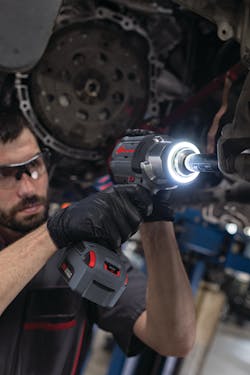
When selling cordless tools, it doesn’t take long to realize what the technician is most interested in – the power. Here is a closer look at common questions regarding torque.
Why do I see so many terms for torque ratings?
From nut-busting and fastening torque to maximum and loosening torque, there are many terms used by tools manufacturers to describe torque ratings. With no industry standards to follow (and no industry standard for testing), tool manufacturers can use whichever term(s) for their own internal standards.
What is the difference between the terms?
In short, the different terms evolved from two numbers: forward and reverse torque.
Although the tool is essentially putting out the same power regardless of operating in forward or reverse, there are still two different torque numbers. “The reason why depends on the joint or bolt you’re working on,” says Mark Kelly, manager of product marketing at Milwaukee Tool. When in reverse, the tool puts out instantaneous energy, or start up energy, to unfasten the bolt. When in forward, the tool is running the bolt down, slowly tightening more and more, he adds.
As Lauren Chell, group product manager at Mac Tools, describes it “Anything that says loosening, breakaway, or nut-busting is going to be done in reverse, so you’re going to have a bolt or joint that is completely fastened that you need to break loose. Anything that would be labeled as fastening or forward torque is essentially going to be a brand new or unfastened bolt that you need to run down or tighten.”
Is it true, the higher the torque the better?
Not always. Too much torque can cause a lot of damage.
“Overtightening a bolt can be just as bad as under tightening a bolt because it stretches the threads,” Chell says. “It can also damage the actual material that you’re trying to fasten together. There is certainly a sweet spot between over and under tightening.”
Same with lug nuts. Hunter Golden, global product manager of industrial tools at Ingersoll Rand, advises users to always fasten the lug nuts and then follow up with a torque wrench. “It’s important that you don’t over fasten lug nuts before you use a torque wrench to get to your final torque because you can stretch the bolt, and fail it,” he says. “Failing a bolt that attaches a wheel to a car is certainly not a good thing.”
When selecting torque, technicians should also consider the tool’s power to weight ratio, Golden adds. “More torque is typically going to also be heavier,” he says. “You want to make sure you’re making that tradeoff in a reasonable way.”
About the Author
Kayla Nadler
Associate Editor | Vehicle Repair Group
Kayla (Oschmann) Nadler was previously an associate editor for the Vehicle Repair Group.
With an education in journalism and public relations, Nadler contributed to Professional Tool & Equipment News (PTEN) and Professional Distributor magazines, as well as VehicleServicePros.com.
